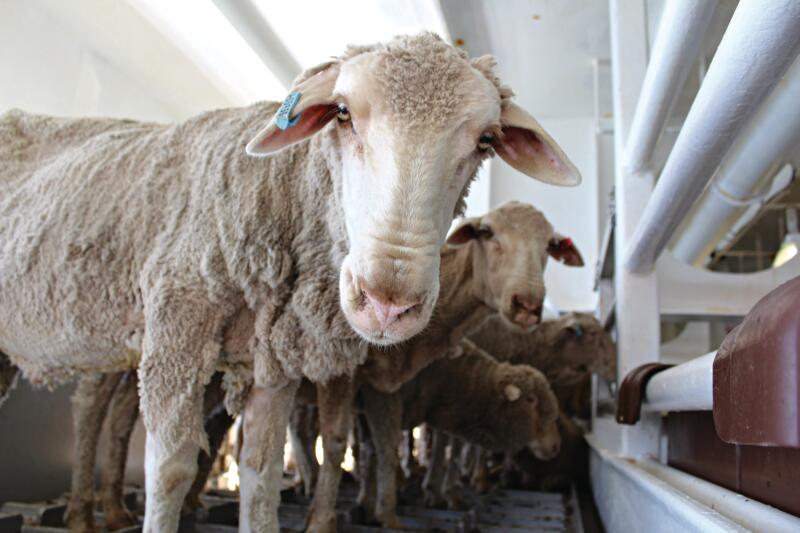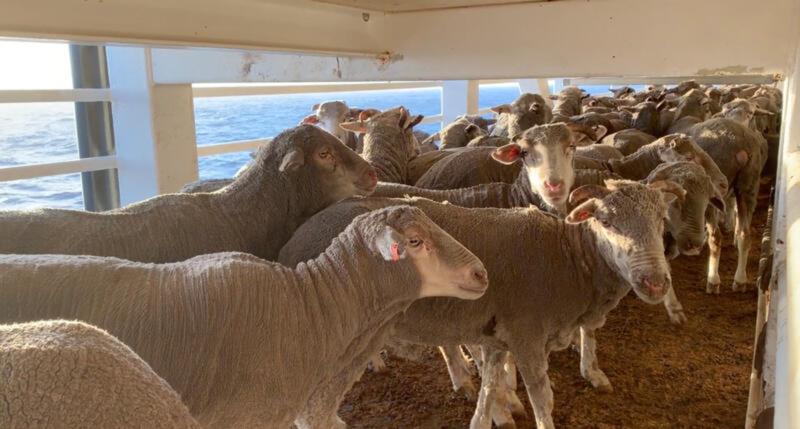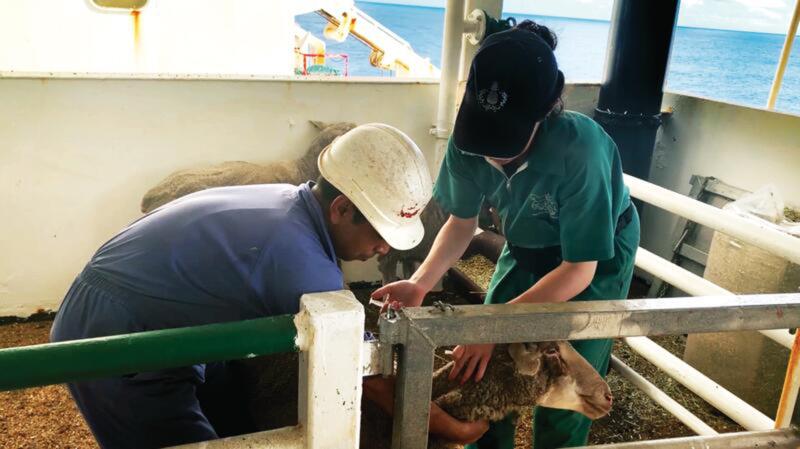LIVE sheep exporters had better reason than most to watch the recent federal election closely. Had Labor won, the sheep export industry was on shaky ground with the party pledging to end the practice altogether.
The Liberal-National coalition victory has put an end to that uncertainty. Incoming Minister for Agriculture Bridget McKenzie has been clear that the live animal export industry will carry on.
“I want to see a sustainable and prosperous live sheep export trade continue. We need to focus on the science and make sure it is robust. I won’t be reacting to emotive arguments.'' - Bridget McKenzie
The Minister said she would head to Western Australia – the main centre of the Australian live sheep export industry – in the coming weeks, where she would meet exporters. “I have regularly met with live exporters when I’ve been in Western Australia over the last few years and will be doing so again on the next visit,” she said. “And I plan to have a tour on a ship at the earliest possible opportunity. I want to get the balance right so the trade can continue.”
She said people needed to be assured and have confidence that live animals could be exported with the highest animal welfare standards. The Minister added she was convinced that could be done.
RELATED ARTICLES:
Newcastle set to be export hub
New meat quality labels
Live sheep export industry creates controversy
To explain how the industry reached crisis point, we need to go back two years. When the Awassi Express got underway from its dock in Fremantle, Western Australia in August 2017, nobody anticipated it was set to sail straight into a perfect storm of public outrage and political controversy.
_preview.jpg) Awassi Express docked in Fremantle in 2015. Source: Supplied.
Awassi Express docked in Fremantle in 2015. Source: Supplied.
The 40,000-tonne, 182m-long vessel, one of the world’s largest livestock carriers, had just loaded more than 63,000 Australian sheep, destined for the Middle East and the annual cultural and religious festivals that are an integral part of the Islamic faith.
What happened aboard Awassi Express during that voyage was to prove a watershed moment for Australia’s live export industry. Activists from Animals Australia, an animal protection group, paid an informer to film conditions aboard the vessel. As it happened, more than 2,400 animals died during the trip, mostly from heat stress.
The film, which was sent to the then-Minister for Agriculture David Littleproud and broadcast on TV by 60 Minutes in April last year, caused shock waves across the nation.
In the wake of the controversy, a series of suspensions and cancellations of export licences effectively stalled sheep shipments for part of 2018, leading to a 41% drop in the trade for the year.

The annual value of Australia’s live export is $1.4 billion.
Live sheep trade has ceased exports to Middle East during summer
The federal
Department of Agriculture and Water Resources (DAWR) has now banned sheep exports from Australia to the Middle East from June to August, the hottest and most humid months in the Middle East. The hope is that by avoiding export in those conditions, the remaining nine trading months will provide a stable environment for the trade and animal welfare. However, conditions for shipping in September and October are still under review.
The danger, critics of the move say, is that international competitors will rush to fill the needs of Australia’s Middle East customers – and many of these countries have lower welfare standards.
Meat & Livestock Australia predicts replacement sheep will be drawn from Sudan, Somalia, India, Romania and Georgia.
So what does the summer ban mean for the future of the industry? Is it, as some animal welfare advocates claim, the first nail in the coffin for a trade that exported 1.9 million sheep in 2017-18, valued at $259 million? Farmers who rely on income from live sheep exports have been concerned about what such a move will mean for their livelihoods and what unintended impacts may await them in the future.
Chilled alternatives could create market challenges for live sheep trade
Calls to end live exports altogether have had some influential advocates. Last year, the Australian Council of Trade Unions congress unanimously supported a motion by the
Australasian Meat Industry Employees’ Union to end the live export of both sheep and cattle.
RSPCA senior policy officer Jed Goodfellow says domestic processing is the only way to ensure the welfare of Australian animals. “Investment in a chilled and frozen meat trade would prevent the suffering inherent to live export and save millions of animals from the cruel fate awaiting them at their destination and on board ships,” he said.
However, NSW Farmers’ president James Jackson, a sheep and cattle producer and former veterinarian who once helped vaccinate animals for the live export trade, says such statements fail to make a pragmatic assessment of the trade.
“One of the things the live sheep trade does for farmers is you can move a lot of sheep quickly in the face of a drought or increased demand. Obviously livestock producers in Western Australia would have been most impacted, but by removing live export as an option, you also remove competitive tension from the livestock market. That would go right through to the eastern states as well.”
 Sheep onboard a live export carrier. Souce: The Sheep Collective.
Sheep onboard a live export carrier. Souce: The Sheep Collective.
Australian Live Exporters’ Council CEO Mark Harvey-Sutton says a reduction in prices for sheep in the domestic market would be inevitable if the live export market disappeared.
“It would have a kick-on effect through the economy, too, because there are lots of associated businesses and industries that rely on servicing the trade so it wouldn’t just be farmgate prices,” he says.
An outright ban on live exports would also fly in the face of changes the industry has already made to improve animal welfare.
“Many people have picked up the emotive side of this argument without examining the realities behind the trade,” - James Jackson.
The live export trade is committed to animal welfare and ensuring that the highest practices are upheld. This is an ongoing process but there is a clear commitment to ensure high welfare outcomes.
Meanwhile, the DAWR says that replacing live exports with chilled meat processing is not just impractical but ignores market realities.
“Suggestions that the live trade could be completely replaced by chilled and frozen meat fails to take into account the requirements of the market,” the department says in a statement.
“While Australia has developed a significant trade in meat products, the lack of refrigeration, as well as strong cultural preferences for freshly slaughtered meat, precludes Australia from servicing all of its export markets with processed meat products.”
RELATED ARTICLES:
From paddock to Asia
Country of origin labelling
The new summer rules for sheep exports
After considering feedback and following numerous consultations across live export regulation, the
Department of Agriculture and Water Resources has finalised the conditions for sheep exports to the Middle East during the northern summer.
As well as prohibiting sheep exports from 1 June to 31 August 2019, additional conditions were imposed on exporters during May this year, allowing for more space for the sheep, independent auditing of pen air turnover readings, automatic watering arrangements and a reduced notifiable mortality level of 1%.
 Australia government-accredited veterinarian Peta Lewis and a crew member treating sheep in the hospital pen on board a ship. Source: The Sheep Collective.
Australia government-accredited veterinarian Peta Lewis and a crew member treating sheep in the hospital pen on board a ship. Source: The Sheep Collective.
The department said in a statement at the end of March: “We remain committed to a regulatory system that establishes the highest standards of animal welfare based on the best possible evidence. The prohibition and conditions were finalised following a thorough examination across all aspects of live export regulation. The strict conditions mitigate the known risks, while further work is underway and new, more comprehensive evidence is analysed.”
It added that independent observers provide an additional layer of assurance that exporters are complying with their requirements, and that conditions for September and October are not settled. “These will be determined once the Heat Stress Risk Assessment panel has completed its review, a Regulation Impact Statement has been undertaken and any additional evidence examined,” the statement said.
Ahead of the election, Shadow Minister for Agriculture Joel Fitzgibbon alleged that the heat stress report was already back in, but it deliberately had not been released by the government. “David Littleproud [the then-Minister for Agriculture] wants to kick the report to the other side of the election because he knows that heat stress report is going to be the end of the trade,” the Shadow Minister said.
While working as a veterinarian NSW Farmers’ president James Jackson helped vaccinate animals for the live export trade
James Jackson, President, NSW Farmers

When I vaccinated sheep for the live export trade 35 years ago, the mortality rate on those journeys was 5%. The average mortality rate now is less than 1%. Often the mortality rate is less than half of 1%.
Many people do not know that Australia is the only country in the world to invest in animal welfare with its live export trading partners.
There are 124 countries that export live animals around the world and there is only one that invests in animal welfare outcomes at the end of the journey – and that is Australia.
We have made a huge investment in training people in these destinations’ markets in the way animals are handled, and that has resulted in lifting the welfare standards, not just for Australian sheep and cattle but also the welfare outcomes for other animals sourced from other countries.
We are the only country that makes these investments. Our trade is helping to bring about behavioural change in the destination countries. We are helping initiate changes in animal welfare that will be around long after all the other bits and pieces have turned to dust. Trade is a good thing. It helps people exchange ideas and the live export trade is no different.
Fast facts about live sheep exports
- 41% reduction in live sheep exports from Australia in 2018, compared to 2017, due to bans and restrictions.
- 15: The number of destinations that live sheep from Australia travelled to in 2018.
- 95% of Australian live sheep exports go to the Middle East.
- 30% of all live sheep exports went to Qatar, our biggest market in 2018.